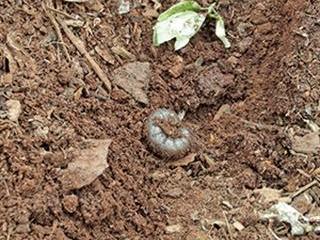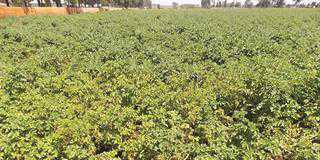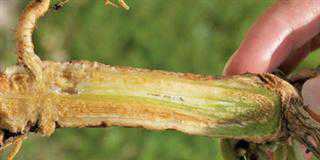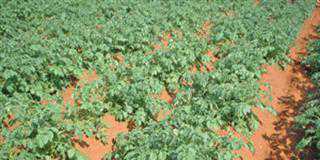
These are an ever-present threat and, if precautions aren’t taken, will cause considerable damage. I was caught out many times in my early farming days by assuming that cutworms wouldn’t be present as the land was clean before planting, or we had just gone through a frosty winter. But these tough critters can survive on crop debris we wouldn’t even notice.
You can replant where damage has occurred, but usually by the time this is discovered and replacements planted, there will be a difference in development between plants. You also might not be able to get plants of the same variety by this time. Cutworms are entirely avoidable, however, as pyrethroids are effective against this pest and easy to apply – ideally at least a day or two before planting.
Millipedes & Mole crickets
Another pest is the millipede, and even small ones can kill off a plant. The problem is that they often remain underground and can move around under loose soil, making them hard to find. You’ll sometimes find a plant dying, dig into the soil to determine the cause and find the stem completely or partially eaten, with rough edges. By contrast, cutworms tend to make a clean cut at, or just below, the soil surface and draw leaves down into the soil.
With millipedes, you may have to dig into a large area to find the culprit. Mole crickets can also do a lot of damage and make deep tunnels. These are extremely difficult to find and it can be a huge mystery when the plants were chewed off underground and after extensive digging, find no insects.
A clue is that one usually finds holes 5mm 8mm on the soil surface and if the soil is carefully dug, their tunnels will be seen underground. If a shill noise is heard at night, it is another clue. Only adults will make this noise with their wings. A pyrethroid drench can help get rid of this difficult pest. Apart from killing young plants, they can also suppress the growth of older plants by eating the root system.
Larvae
Segmented and straw-coloured, wire worms are an occasional pest, especially when weedy soil is worked not long before planting. They’re easy to find when digging out a dying plant and are the larvae of various ground beetles. If you spot this type of beetle on the soil before land preparation, be on the lookout for the worms. Some insecticidal drenches can help. White grubs are the larvae of chafer beetles. These are those brown flying beetles which are attracted to your lights on warm summer evenings. The grubs are C-shaped with a red or brown head. Control is difficult and is the same as for wire worms.
Precautions
Unfortunately, apart from cutworms, which are an ever-present threat, all these pests are more likely to occur in soil with a good organic content. And you need to look out for them before planting, when control measures are easier and more effective. If you discover any of them after planting, the damage has already been done. It’s also important to keep the young plants free of leaf pests, especially in areas where diseases are transmitted by these pests.
You can drench or spray seedlings with an insecticide such as Imidacloprid. This systemic product lasts for some time, protecting the plant from damage from sucking insects and, as a drench, perhaps also from some soil insects. It works for white grubs on maize and would probably do the same on tomatoes, but there is no registration in this regard for tomatoes. It’s extremely effective for white fly, a vector for tomato curly stunt virus.
A good early start with a full stand is very important so pay attention to all potential hazards. Land preparation should commence well in advance of planting and insect control for many of the pests mentioned can start long before a crop is planted.
Contact Bill Kerr at [email protected]. Please state ‘Vegetable production’ in the subject line of your email.













